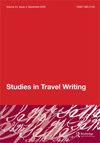观看人群:静态的“我”和移动的“旅行者”
Q2 Arts and Humanities
引用次数: 0
摘要
摘要:每当叙事的前进速度减慢或完全停止时,旅行写作往往会重新调整对他人的表现。与其说是一个移动的主人公注意到存在着基本上静止的、毫无特色的、没有历史可言的旁观者,不如说是极性颠倒了,所以是旅行者移动、经过——或者围绕着——一个旅行者,他显然别无选择,只能与他们进行长距离或深度的接触,哪怕只是在页面上。这篇文章探讨了非小说作品中“人们观看”人物的不同方式,在这些方式中,“我”几乎不动,这对他们使用的表征形式以及赋予观察者和观察者的相对重要性产生了影响。例子来自阿兰·德·博顿、罗杰·格林、索菲·卡勒、安妮·埃尔诺和贝鲁兹·布查尼的文章。本文章由计算机程序翻译,如有差异,请以英文原文为准。
People watching: the static “I” and mobile travellees
ABSTRACT Whenever the forward movement of the narrative slows down – or stops completely – travel writing often realigns its representation of other people. Instead of a mobile protagonist who notes the existence of largely static and featureless by-standers with no history to speak of, the polarities are reversed, so that it is the travellees who are the ones who move, passing by – or revolving around – a traveller who stays put with apparently little choice but to engage with them at length or in depth, if only on the page. This article examines different ways “people watching” figures in non-fiction writings in which the “I” barely moves and the impact this has on the forms of characterisation they use and the relative importance assigned to the observer and observed. Examples are drawn from texts by Alain de Botton, Roger Green, Sophie Calle, Annie Ernaux and Behrouz Boochani.
求助全文
通过发布文献求助,成功后即可免费获取论文全文。
去求助
来源期刊

Studies in Travel Writing
Arts and Humanities-Literature and Literary Theory
CiteScore
0.40
自引率
0.00%
发文量
13
期刊介绍:
Founded in 1997 by Tim Youngs, Studies in Travel Writing is an international, refereed journal dedicated to research on travel texts and to scholarly approaches to them. Unrestricted by period or region of study, the journal allows for specific contexts of travel writing to be established and for the application of a range of scholarly and critical approaches. It welcomes contributions from within, between or across academic disciplines; from senior scholars and from those at the start of their careers. It also publishes original interviews with travel writers, special themed issues, and book reviews.
 求助内容:
求助内容: 应助结果提醒方式:
应助结果提醒方式:


